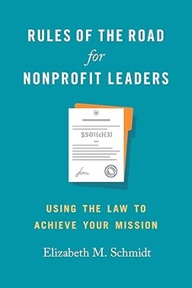Rules of the Road for Nonprofit Leaders is a common-sense primer
First, some personal news: I got a law degree. Then, I began working right away at nonprofit organizations—a think tank in 1993, a private foundation in 1998, then another think tank in 2017. I self-servingly thought the professional credential would add at least some value to the different groups’ missions, others must’ve thought so too, and I suppose—hope?—it may have. You know, good advice and guidance. We lawyers have been taught to really think! Perfect for a policy researcher and program officer. I mean, who else would instinctively know “§” or that “exclusively” really only means “primarily”?
Then, at some point during those decades, came into contact with professional accountants. They had a lot of advice and guidance about how to run the nonprofit, too. Well, really more, um, directive guidance. If not followed, however, the implication was that the place’s very tax-exempt status was at risk. Sometimes there seemed to be something akin to a threat: fill out and sign this form we’re giving you or it’s all over. Has to be done because of blah blah blah the Internal Revenue Service mumbo mumbo jumbo Revenue Ruling.
Then, of course, there were money managers with their own blah blahs who got their cut of the action out of advising and guiding the place. “No money, no mission;” often something about “basis points,” as well. Then, there were M.B.A.s, with strategic, value-added ideas—from business! business!!—and acronyms of their own. ROI. If you don’t know, do not ask.
Professionalism be praised. Nonprofitdom needs, and benefits greatly from, it. Getting a little crowded in these rooms, though, with all the high-paid givers of advice to help nonprofits, apparently necessarily followed or else …. In fact, where’d that public-relations expert come from? It’s always important to know your audience, be sure the reporter knows whether you’re on or off the record, SEO. Don’t ask. Nod, receptively. No, knowingly.
And, oh, there’s a newly scheduled 4 p.m. Zoom call with the team of fundraising consultants about an only-potential capital campaign years from now.
Risk and fear
Do people at all nonprofits, whether a grantmaking private foundation or a grant- and donation-seeking and -receiving public charity, have to put up with all of this? Well, for the most part, yes. Yes, they do. Their leaders at least have to assume the risk of ignoring or subordinating offered advice from professionals to worrying about or performing everyday, perhaps-urgent tasks in carrying out the nonprofit’s mission. Or, they have to live with the fear of thinking that doing the task before considering the advice might cause actual legal or other trouble. Or worse, they don’t even really get the advice; they just second-handedly hear about what it’d be if they did.
Both the risk and fear are much higher, of course, for smaller, grassroots nonprofits with lesser budgets, fewer connections with whatever-relevant establishment institutions, and likely more-overworked staffs. And for some of these groups, (again) of course, the mission requires making sure there’s enough food to distribute to the hungry or beds on which homeless people can sleep tonight. Professionalism be damned.
For leaders of these and similar nonprofits having to put up with the specters of this risk and fear in the legal context in particular, there’s University of Massachusetts Amherst professor Elizabeth M. Schmidt’s Rules of the Road for Nonprofit Leaders: Using the Law to Achieve Your Mission, from Georgetown University Press’ new series of books on philanthropy, nonprofits, and nongovernmental organizations.
“This book is an attempt to explain nonprofit law to current and future nonprofit leaders in a way that speaks to their active and ethical natures,” Schmidt writes in its preface.
This is no easy task, as the law is full of nuances, and if I tried to explain all the nuances, the book would no longer be clear to the readers. Instead, I have tried to strike a balance between being general enough to be understandable and specific enough as to not be misleading. The book is a basic translation of the law, which should provide nonprofit leaders with a general framework for understanding what nonprofit leaders can do within the boundaries of the law.
It succeeds. It is helpful, appealing to common-sense ideas and inclinations, and policies and practices. Relatedly, it uses plain English. Importantly, it’s not legally boundary-pushing, as is much of the free advice and guidance pushed on nonprofit leaders. Its plain language is instead merely descriptive of boundaries, even if necessarily at the levels of abstraction where law and/or regulation has them “defined” now.
Basic problem-avoidance
Overall, Schmidt warns, entities categorized as nonprofits under Internal Revenue Code § 501(c)(3) unfortunately operate within “an outdated, complex, one-size-fits-all, and negative legal framework, which is further complicated by outmoded professional practices.” Wanting to alternatively present an empathetic positive “case”—no list of fret-causing “thou shalt nots” here—she organizes her Rules of the Road for Nonprofit Leaders into eight precepts, each accorded its own chapter.
As Schmidt acknowledges, they’re good precepts to follow even external to the context of any specific legal situation or questions that may arise. Adhering to them, however, will likely help avoid legal problems. They are:
“1. Keep the mission front and center.
“2. Govern wisely.
“3. Fill the coffers.
“4. Go into business?
“5. Treat your friends and colleagues well—just not too well.
“6. Advocate for your cause.
“7. Complete the paperwork.
“8. Know how to change course.”
Just as she explains the work’s general purpose, and then as she explains each specific precept, they essentially restate the relevant laws and regulations applicable to nonprofits, including: the importance of the stated purpose of the nonprofit, how and why it should be to benefit the wider public, the eight different types of specific purposes for which the tax benefit of exempt status can be conferred; fiduciary duties of board members and officers; how to handle donations and foundation grants; how to handle earned revenue and commercial activity; fair compensation of officers and employees; policy advocacy, legislative lobbying, and political campaign intervention; and documentation and public disclosure.
So, yeah, the precepts probably are a little more easily absorbable.
Boundaries and other betterments
Schmidt’s concluding chapter is actually another moderate, restrained overview—in this case, of what she calls “a constructive way forward” towards changing nonprofit law to better help the sector and nonprofits in it pursue their purposes and meet their missions. First, there is a “need for clearer boundaries around the concept of charitable,” she writes (emphasis in original), including between charitable and commercial enterprises and between charitable and political purposes.
Second, she surveys proposed modifications of the charitable-deduction rules, including in the problematic context of donor-advised funds. “The guiding principles of this discussion should be simplification, clarity, and the creation of incentives to move the funds to those charities that are actively carrying out the charitable mission,” she recommends. “There will be opposition,” she notes, including “from those who are invested in the current system ….”
Third, Schmidt also floats the idea of reconsidering the distinction between those nonprofits that are private foundations and those that are public charities. “Congress created this distinction because it assumed that § 501(c)(3)s remaining under the control of a single person or a small group of people needed more rules with stricter remedies than organizations that are more accountable to the general public,” she writes, but “[a]lmost every provision that private foundations must follow now has a counterpart in the public charity world.”
Keeping the crowd small
There are other books trying to “explain” law, accounting, business principles, public relations, and fundraising to nonprofit leaders. There are also conferences and webinars, of course. If and when need be, there is also no shortage of professionals you can pay to come in and (further?) crowd your office or put on retainer—and Schmidt doesn’t hesitate to urge that you do so if and when need be in the legal context. For a good, helpful, common-sense, plain-English legal primer, though, her Rules of the Road for Nonprofit Leaders is well worth the read.
Don’t bill your time.
—
This article first appeared in the Giving Review on August 4, 2025.
Source: https://capitalresearch.org/article/rules-of-the-road-for-nonprofit-leaders-is-common-sense-primer/
Anyone can join.
Anyone can contribute.
Anyone can become informed about their world.
"United We Stand" Click Here To Create Your Personal Citizen Journalist Account Today, Be Sure To Invite Your Friends.
Before It’s News® is a community of individuals who report on what’s going on around them, from all around the world. Anyone can join. Anyone can contribute. Anyone can become informed about their world. "United We Stand" Click Here To Create Your Personal Citizen Journalist Account Today, Be Sure To Invite Your Friends.
LION'S MANE PRODUCT
Try Our Lion’s Mane WHOLE MIND Nootropic Blend 60 Capsules
Mushrooms are having a moment. One fabulous fungus in particular, lion’s mane, may help improve memory, depression and anxiety symptoms. They are also an excellent source of nutrients that show promise as a therapy for dementia, and other neurodegenerative diseases. If you’re living with anxiety or depression, you may be curious about all the therapy options out there — including the natural ones.Our Lion’s Mane WHOLE MIND Nootropic Blend has been formulated to utilize the potency of Lion’s mane but also include the benefits of four other Highly Beneficial Mushrooms. Synergistically, they work together to Build your health through improving cognitive function and immunity regardless of your age. Our Nootropic not only improves your Cognitive Function and Activates your Immune System, but it benefits growth of Essential Gut Flora, further enhancing your Vitality.
Our Formula includes: Lion’s Mane Mushrooms which Increase Brain Power through nerve growth, lessen anxiety, reduce depression, and improve concentration. Its an excellent adaptogen, promotes sleep and improves immunity. Shiitake Mushrooms which Fight cancer cells and infectious disease, boost the immune system, promotes brain function, and serves as a source of B vitamins. Maitake Mushrooms which regulate blood sugar levels of diabetics, reduce hypertension and boosts the immune system. Reishi Mushrooms which Fight inflammation, liver disease, fatigue, tumor growth and cancer. They Improve skin disorders and soothes digestive problems, stomach ulcers and leaky gut syndrome. Chaga Mushrooms which have anti-aging effects, boost immune function, improve stamina and athletic performance, even act as a natural aphrodisiac, fighting diabetes and improving liver function. Try Our Lion’s Mane WHOLE MIND Nootropic Blend 60 Capsules Today. Be 100% Satisfied or Receive a Full Money Back Guarantee. Order Yours Today by Following This Link.







